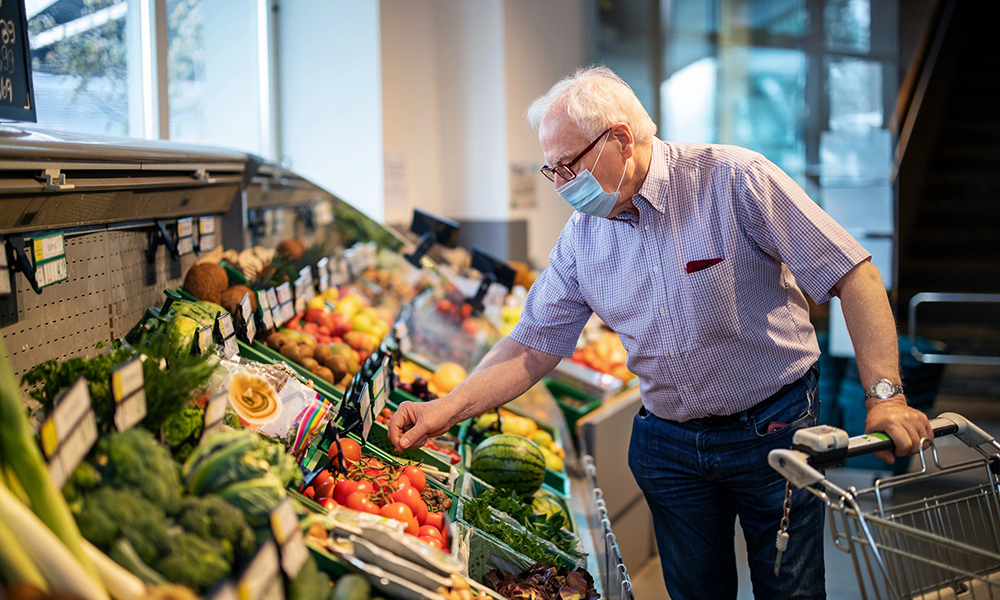数以百万计的美国人没有能力摆脱疫情,亟需帮助

近三年前疫情爆发时,美国老年人就很脆弱。
他们今天仍然如此。
根据美国疾病控制与预防中心(CDC)的数据,自2020年以来,65岁以上人群占与新冠相关死亡人数的75%以上。相较于18-29岁人群,65-74岁人群因新冠肺炎住院的风险提高5倍;75-84岁人群住院风险提高到近9倍,85岁以上人群的住院风险提高了15倍。
波士顿大学公共卫生学院卫生不平等战略研究领域的负责人朱莉娅·拉夫曼(Julia Raifman)博士告诉《纽约时报》:“新冠肺炎疫情的成本仍然很高。”
在大流行开始时,新冠肺炎疫情就席卷了养老院,确诊病例激增,成为新冠疫情的震中。2020年3月,我清楚地记得一位调查记者、我以前的教授打来的关切电话,当时她每天都在搜索最新新闻资讯,却看到老年社区的确诊病例激增,而且激增速度非常快。
2020年3月,我与教授领导的团队合作,记录了养老院疫情爆发,以及众多家庭失去亲人的令人心碎的故事。几个月的报道让我们了解到,旨在保护老年人的机构辜负了他们的期望,而幸存下来的家庭成员感觉他们的亲人只不过是屏幕上新闻里的一个数字。
快进到疫苗推广阶段,政府开始取消隔离限制措施,人们开始恢复所谓的正常生活。然而,随着亚型变异株占据主导地位,其免疫逃避能力也越来越强,再加上全美疫苗接种率较低,老年人仍然处于高风险之中。
正如《纽约时报》报道的那样,老年人和他们的家人持续感受到疫情的余波,无论是面临危重疾病带来的影响,还是由于担心感染病毒而不断回避正常生活。
如何保护最脆弱的人群
那么,在保护脆弱人群方面,企业应尽怎样的义务?据《纽约时报》报道,在疫情爆发早期,许多企业设立了“老年人专属时间”,让美国老年人可以在更安全、隔离条件更好的环境中购物。然而,这些便利措施已经不再司空见惯。
拉夫曼告诉《纽约时报》说:“担心感染病毒的人群还是不敢进入公共空间。”
然而,拉夫曼说,现在有一个“中间地带”,这个“中间地带”不会再次把世界搅得天翻地覆。对于那些仍然想采取预防措施的老年人来说,这意味着要创造一个空间,让他们能够与他人接触,外出办事,并按照自己感觉舒适的方式享受生活。例如,公共场所可以要求人们在指定时间里佩戴口罩或保持社交距离。
拉夫曼告诉《纽约时报》说:“我们可以用更智能和包容的方式来减少病毒传播。”
对其他人来说,这可能看起来像是在感到不适时采取预防措施。这意味着人们要避免这样的想法,即你必须在生病时坚持工作,但是这样做的话,只会导致那些易感人群感染病毒。密歇根大学的传染病专家雷蒂·马拉尼(Preeti Malani)博士此前曾对《财富》杂志表示:“要逐渐接受并鼓励人们说‘我身体不适’和‘我不能来上班’。”(财富中文网)
译者:中慧言-王芳
近三年前疫情爆发时,美国老年人就很脆弱。
他们今天仍然如此。
根据美国疾病控制与预防中心(CDC)的数据,自2020年以来,65岁以上人群占与新冠相关死亡人数的75%以上。相较于18-29岁人群,65-74岁人群因新冠肺炎住院的风险提高5倍;75-84岁人群住院风险提高到近9倍,85岁以上人群的住院风险提高了15倍。
波士顿大学公共卫生学院卫生不平等战略研究领域的负责人朱莉娅·拉夫曼(Julia Raifman)博士告诉《纽约时报》:“新冠肺炎疫情的成本仍然很高。”
在大流行开始时,新冠肺炎疫情就席卷了养老院,确诊病例激增,成为新冠疫情的震中。2020年3月,我清楚地记得一位调查记者、我以前的教授打来的关切电话,当时她每天都在搜索最新新闻资讯,却看到老年社区的确诊病例激增,而且激增速度非常快。
2020年3月,我与教授领导的团队合作,记录了养老院疫情爆发,以及众多家庭失去亲人的令人心碎的故事。几个月的报道让我们了解到,旨在保护老年人的机构辜负了他们的期望,而幸存下来的家庭成员感觉他们的亲人只不过是屏幕上新闻里的一个数字。
快进到疫苗推广阶段,政府开始取消隔离限制措施,人们开始恢复所谓的正常生活。然而,随着亚型变异株占据主导地位,其免疫逃避能力也越来越强,再加上全美疫苗接种率较低,老年人仍然处于高风险之中。
正如《纽约时报》报道的那样,老年人和他们的家人持续感受到疫情的余波,无论是面临危重疾病带来的影响,还是由于担心感染病毒而不断回避正常生活。
如何保护最脆弱的人群
那么,在保护脆弱人群方面,企业应尽怎样的义务?据《纽约时报》报道,在疫情爆发早期,许多企业设立了“老年人专属时间”,让美国老年人可以在更安全、隔离条件更好的环境中购物。然而,这些便利措施已经不再司空见惯。
拉夫曼告诉《纽约时报》说:“担心感染病毒的人群还是不敢进入公共空间。”
然而,拉夫曼说,现在有一个“中间地带”,这个“中间地带”不会再次把世界搅得天翻地覆。对于那些仍然想采取预防措施的老年人来说,这意味着要创造一个空间,让他们能够与他人接触,外出办事,并按照自己感觉舒适的方式享受生活。例如,公共场所可以要求人们在指定时间里佩戴口罩或保持社交距离。
拉夫曼告诉《纽约时报》说:“我们可以用更智能和包容的方式来减少病毒传播。”
对其他人来说,这可能看起来像是在感到不适时采取预防措施。这意味着人们要避免这样的想法,即你必须在生病时坚持工作,但是这样做的话,只会导致那些易感人群感染病毒。密歇根大学的传染病专家雷蒂·马拉尼(Preeti Malani)博士此前曾对《财富》杂志表示:“要逐渐接受并鼓励人们说‘我身体不适’和‘我不能来上班’。”(财富中文网)
译者:中慧言-王芳
When the pandemic broke out nearly three years ago, older Americans were vulnerable.
They still are today.
Since 2020, people 65 and over have comprised over 75% of COVID-related deaths, according to the U.S. Centers for Disease Control and Prevention (CDC). Those between age 65 and 74 are roughly five times more likely to be hospitalized for COVID-19 than those between 18 and 29; the rate rises to nearly nine times as likely for those 75 to 84, and 15 times as likely for those 85 and older.
“There continue to be very high costs of COVID,” Dr. Julia Raifman, leader of the Health Inequities Strategic Research area at the Boston University School of Public Health, tells the New York Times.
At the outset of the pandemic, COVID-19 swept through nursing homes as they became the epicenter for massive outbreaks. In March 2020, I distinctly remember a concerned call from an investigative reporter and past professor of mine, as she scoured daily news updates only to see how quickly cases rose in senior communities.
In March 2020, I worked with a team led by my professor to document the nursing home outbreaks along with the heartbreaking accounts from families who lost loved ones. Months of reporting led us to understand that institutions meant to protect seniors were failing them—and the family members left behind felt as if their relatives were reduced to nothing more than a number spread across a news screen.
Fast-forward to vaccine rollouts, and isolation measures rolled back—people began to resume their so-called normal lives. However, with subvariants dominating the scene and becoming more immune evasive, along with low national vaccination rates, seniors are still at high risk.
As the New York Times reports, seniors and their families continue to feel the fallout, whether from the repercussions of facing severe illness or the constant avoidance of normal life due to fear of contracting the virus.
How to protect the most vulnerable
So what obligation is there to protect those still vulnerable? In the early days of the pandemic, many businesses instituted “senior hours,” when older Americans could shop in a safer, more isolated environment, the New York Times reports. However, those accommodations are no longer commonplace.
“Public spaces are not accessible to people concerned about infections,” Raifman tells the New York Times.
However, Raifman says there is a “middle ground,” which doesn’t turn the world upside down again. For those seniors who still want to take precautions, it means creating spaces where they can engage with others, complete their errands, and enjoy life in a way that feels right for them. Public spaces could create specified times allotted for masking or social distancing, for example.
“We can mitigate transmissions in smart and inclusive ways,” Raifman tells the New York Times.
For others, it can look like taking precautions when feeling ill. It means avoiding the idea that you must push through and work when sick, only to infect those who may be more vulnerable to severe illness. “It becomes socially acceptable and in fact very, very encouraged for people to say, ‘I’m not feeling well’ and ‘I can’t come to work,’” Dr. Preeti Malani, an infectious disease specialist with the University of Michigan, previously told Fortune.













